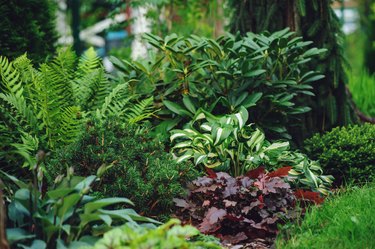
Weed killer can damage or kill non-targeted plants, but you may be able to save plants from injury if you act quickly. Whether or not you can save the plant depends largely on the type of weed killer used and the extent of the damage. Recognizing the signs and helping the plant grow stronger can save it from dying.
How Does Damage Happen?
Video of the Day
Understanding how weed killer damage happens can help you determine if the symptoms you're seeing were actually caused by herbicide. It can also help you determine the best way to treat the herbicide damage.
Video of the Day
Weed killer can drift onto plants you want to keep if you use it on a windy or hot day. Mild, calm, overcast days are best for applying herbicide. You can also accidentally apply it to a plant through a poorly cleaned garden sprayer or watering can. When you use it for something else, small traces of the chemicals can get on the plant.
The contamination can also happen through the soil or ground covering. Some weed killers can leach into nearby growing areas. Plant roots can soak up residual herbicides if they're applied at too high of a rate. Compost can become contaminated from weeds or plants containing hormonal herbicides. Garden mulch can also be contaminated if you move it from an area that was treated or if you mulch with grass clippings that were treated with certain herbicides.
Signs of Weed Killer Damage
The signs of weed killer damage can vary depending on the type of herbicide and the way the plant was contaminated. The symptoms might also look different on different plant species. General symptoms can include discoloration, curling, stunted growth and dead spots.
Lawn herbicides and other weed killers with 2,4-D and MCPP can cause leaves and shoots to twist or become deformed. Trifluralin affects the roots, causing them to swell or become shortened. The lawn herbicide dicamba can cause distorted or discolored foliage that's smaller than normal.
Glyphosate is a nonselective weed killer that can stop growth and kill any plant it touches. It can take several days for the leaves to turn yellow and then brown from the glyphosate. If the damage happens in the fall, the plant might show signs of damage in the spring.
Spray the Plant With Water
If you become aware of the weed killer contamination immediately, hose off the plant to wash away as much of the herbicide as possible. Once the plant absorbs the chemicals, hosing it off won't help, so this option needs to happen quickly. Spraying off the foliage also doesn't help if the weed killer was absorbed through the roots since there's nothing to wash off.
Provide Proper Care
Watering the damaged plants thoroughly can help minimize damage if the roots were affected. It helps to dilute the chemicals and could prevent the plant from absorbing as much of the weed killer if done right away. Continue watering your plant regularly, especially during dry periods, to keep it well hydrated and to avoid water stress.
Fertilizing with the appropriate type of fertilizer for that plant species can also help. Watch for pest infestations and get rid of the bugs early to prevent it from becoming even more damaged. These options give the plant the care it needs to be strong and grow vigorously, which can help it overcome the weed killer damage.
Remove Damaged Portions
Removing the damaged portions of the plant may help it recover quicker. Use sanitized pruning shears to cut out brown or black portions that appear dead. Remove abnormal growth as well. The damaged growth can continue for some time. Keep up with regular pruning until the plant starts to recover and returns to normal growth.
Give It Time to Recover
Many plants simply need time to recover from herbicide damage. Some plants might die, but others will recover over time. Some shrubs and trees can take years to return to normal growth. As long as the plant still shows some signs of life, you can continue waiting it out.
If you decide to dig up the plant and replace it, hold off on planting anything new. Depending on which herbicide you used, the chemical compounds can still be in the soil, which means the new plant can absorb them and become damaged as well.